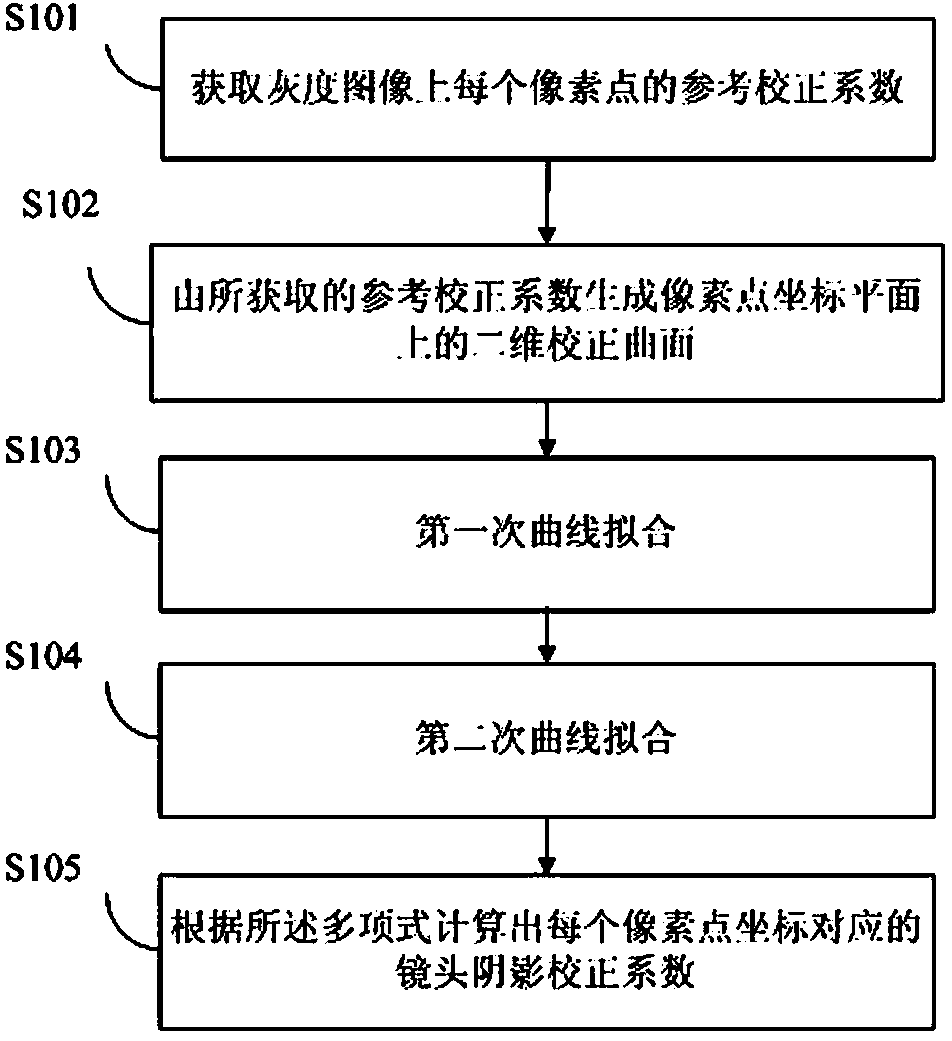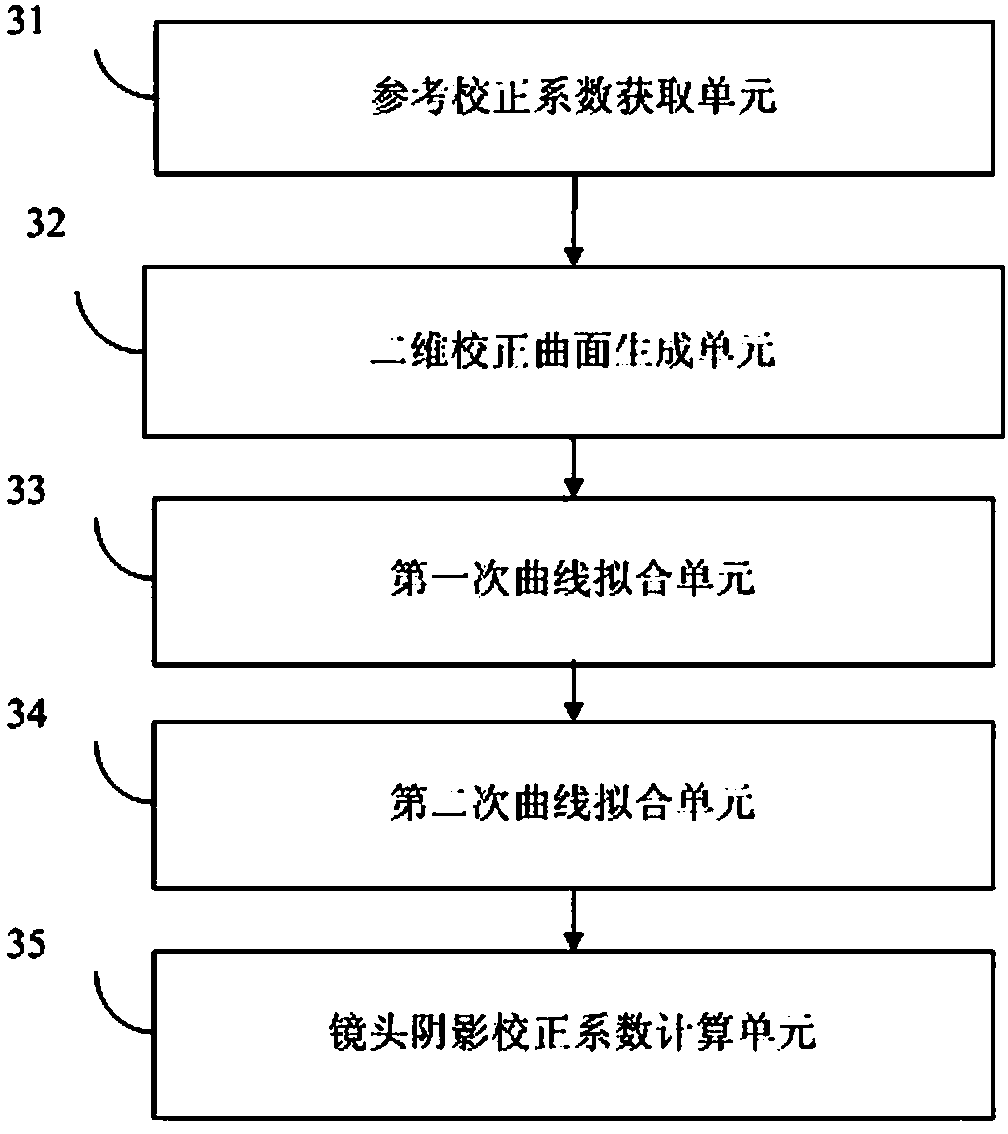Camera lens shadow correction coefficient determination method and device, and camera lens shadow correction method and device
A lens shading and correction coefficient technology, applied in the field of image processing, can solve the problem of unsatisfactory lens shading correction effect, etc., and achieve the effect of good correction effect, simple implementation method, and small implementation area.
- Summary
- Abstract
- Description
- Claims
- Application Information
AI Technical Summary
Problems solved by technology
Method used
Image
Examples
Embodiment 1
[0033] Such as figure 1 As shown, the lens shading correction coefficient determination method provided by Embodiment 1 of the present invention includes the following steps:
[0034] S101: Obtain a reference correction coefficient for each pixel on the grayscale image.
[0035] In the specific implementation, after taking a grayscale image with uniform brightness distribution with the lens, the real pixel value of each pixel point of the captured image is obtained, the brightest point in the grayscale image is selected as the standard value, and the difference between the standard value and the photographed value is calculated. The ratio of the real pixel values of each pixel of the image to obtain the reference correction coefficient of each pixel. The grayscale image refers to an image in which each pixel has only one sampled color. In this embodiment, it is assumed that the size of the lens is 1200 rows*1600 columns, and a grayscale image with a size of 1200*1600 is ca...
Embodiment 2
[0068] Such as figure 2 As shown, the flow of the lens shading correction method provided by Embodiment 2 of the present invention includes the following steps:
[0069] S201: Acquire the image to be corrected, and acquire the pixel values of the pixels corresponding to the current pixel coordinates in order of pixel coordinates.
[0070] S202: Obtain a lens shading correction coefficient corresponding to the current pixel coordinates.
[0071] Wherein, the determination method of the lens shading correction coefficient is:
[0072] Obtain the reference correction coefficient of each pixel on the grayscale image; in specific implementation, after taking a grayscale image with uniform brightness distribution with the lens, the real pixel value of each pixel of the captured image is obtained, and the grayscale image is selected The brightest point is the standard value, and the ratio of the standard value to the real pixel value of each pixel in the captured image is calcul...
Embodiment 3
[0089] Such as image 3 As shown, it is a lens shading factor determination device provided by Embodiment 3 of the present invention, which includes
[0090] A reference correction coefficient acquisition unit 31, configured to acquire a reference correction coefficient for each pixel on the grayscale image;
[0091] The two-dimensional correction curved surface generation unit 32 is configured to generate a two-dimensional correction curved surface on the pixel point coordinate plane from the acquired reference correction coefficients. In a specific implementation, a two-dimensional correction surface on the pixel coordinate plane is generated according to the abscissa, ordinate and reference correction coefficient of each pixel;
[0092] The first curve fitting unit 33 is configured to perform unary high-power polynomial fitting on each row on the two-dimensional calibration surface. In a specific implementation, a unary high-power polynomial with the ordinate of the pixel...
PUM
 Login to View More
Login to View More Abstract
Description
Claims
Application Information
 Login to View More
Login to View More - R&D
- Intellectual Property
- Life Sciences
- Materials
- Tech Scout
- Unparalleled Data Quality
- Higher Quality Content
- 60% Fewer Hallucinations
Browse by: Latest US Patents, China's latest patents, Technical Efficacy Thesaurus, Application Domain, Technology Topic, Popular Technical Reports.
© 2025 PatSnap. All rights reserved.Legal|Privacy policy|Modern Slavery Act Transparency Statement|Sitemap|About US| Contact US: help@patsnap.com



